► Compact concept previews next electric generation
► Most economical Merc ever, with lowest drag
► Achieves target of 1000km on a single charge
Mercedes has achieved its massive target of managing 1000km (621 miles) on a single charge with its Vision EQXX.
The hyper-economical EV concept was designed from the ground up to be as efficient as possible, as well as demonstrate new EV technology from Stuttgart that’ll be rolled out in future production cars. It’s been built to champion the virtues of modest power combined with world-leading aerodynamics, is light and simple – relatively speaking – and shows an interior that’s a bold departure from the current Merc cabin that’s evolved over the decades.
On top of that, chief design officer, Gorden Wagener told CAR the EQXX is ‘a promise for what we want to deliver for the C-segment – so C-Class size – as it shows the vision of the exterior and interior.’
How did the EQXX hit its targeted range?
The car was driven from Sindelfingen, the location of one of Merc’s R&D centres, to Cassis in France. The route included everything from autobahn stretches to twisty turns through the Alps

The car was fully charged at the R&D centre, with the charging cap taped up with anti-tamper measures to ensure it was never opened during the drive, with a member of the certification body, TÜV Süd accompanying Mercedes on the drive. Chief technical officer, Markus Schäfer told CAR that there was no trickery with the route, with test drivers hitting 140km/h on the Autobahn 81 and an average speed of 90km/h throughout the entire journey. Schäfer also tells us that the journey was simulated several times before driven in real life, with the real journey throwing in traffic jams and roadworks not predicted by the simulations.
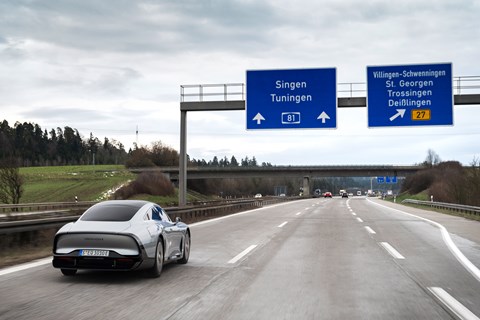
‘Once we were finished, there was still 15 per cent left in the battery,’ says Schäfer, ‘meaning the EQXX was good for a total of 1150km.’ Mercedes claims a battery efficiency of 8.7kWh per 100km.
But how did the EQXX and the testing team achieve this?
It definitely looks slippery…
The drag coefficient is a remarkable 0.18Cd – beating the 0.20 of the EQS – achieved through the car’s shape – low nose, tapered rear, smooth in between – with a bit of help from movable flaps at the front and diffuser at the rear, which protrudes more at higher speeds.
The aerodynamics were also designed to cool the electrics – the airflow under the car passes under a cooling plate that takes away most of the surplus heat, thus reducing the need for heavy, bulky fans and jackets.
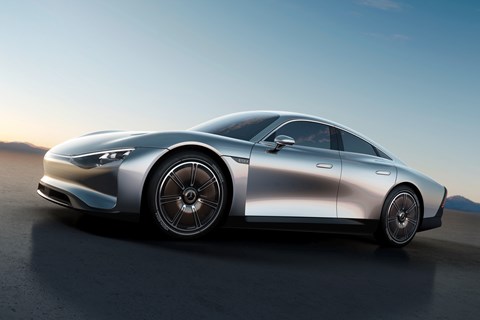
Aero shutters do much of the rest of the work. When they’re not needed, they stay closed, improving aerodynamic performance and in turn lowering the demands on the drive unit.
Interestingly, the EQXX does without a current fad of aerodynamic design: camera door mirrors. Wagener says ‘a real mirror is always better than a mirror camera in terms of visual feedback,’ adding that they weren’t implemented in the EQXX as the additional electronics required ‘mean they’re worse than a real mirror.’
Wow – there’s a proper focus on efficiency, then
Absolutely. The electric drive system is defined by high energy density and high efficiency, and the whole car has been designed to enable low system losses. Eva Greiner, chief electric drive system engineer, said: ‘One of the best ways to maximise efficiency is to minimise losses. We worked on every part of the system to reduce energy consumption and losses through system design, material selection, lubrication and heat management.’
The power electronics unit – featuring a new generation of silicon carbides – is based on the one in the upcoming Mercedes-AMG Project One hypercar.
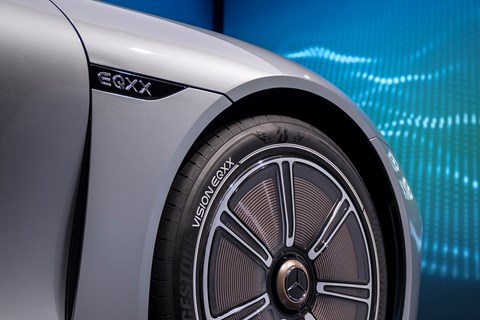
With a net battery capacity of less than 100kWh, the EQXX has an output of around 200bhp, which with a kerbweight of less than 1750kg shouldn’t be slow, but it’s set up to prioritise range, not speed. The EQXX is capable of doing six miles per kWh of energy – far better than current production EVs.
Mercedes has not leapt to solid-state batteries, much vaunted as the next big thing, and has not gone for a big battery, but has instead focused on energy density: the figure of 200Wh/kg makes it possible to fit a battery pack with just under 100kWh of usable energy into a compact car.
Adam Allsopp, advanced technology director at HPP (makers of Merc’s F1 engines), said the battery in the EQXX has almost the same amount of energy as that used in the EQS limo but is half the size and 30 per cent lighter. ‘The battery management system and power electronics have been designed with an absolute focus on minimising losses. In achieving this efficiency milestone, we learnt a lot that will flow into future development programmes.’
The increase in energy density is in part due to the chemistry of the anodes, involving a high silicon content. The battery development team also looked into unusually high voltages, gathering data from experiments with 900-plus volts; they’re currently weighing up the benefits.
The lightweight battery cover was engineered jointly by HPP and the F1 teams chassis operation at Brackley. It’s made from a sustainable composite material derived from sugar-cane waste, reinforced with carbonfibre.
The car’s roof also has 117 solar cells, helping to power some of the ancillary systems and in turn reducing the drain on the main battery. In ideal conditions it could add about 15 miles to the range. Work is ongoing on ways to use solar power to charge the high-voltage system. And, while solar panels themselves haven’t seen mass implementation in production cars (Hyundai’s Ioniq 5 had one as part of its ‘Project 45’ first edition, and the original Nissan Leaf had one as an option), CTO Markus Schäfer says there is more to come in production cars: ‘We do see the value of solar panels – why not use the roof? Instead of tinted glass, we can apply them there – it’s free range.’
Any more sustainability tech to it?
It’s no limo, but the EQXX is intended to be able to carry adults front and rear. The single e-motor is under the boot, driving the rear wheels. That contributes to a simple, reasonably roomy cabin. It makes a break with Mercedes tradition by shunning wood and leather, and instead going big on fabrics made from fast-growing bamboo, artificial silk, cactus pulp and mushrooms, as well as recycled plastic bottles and landfill.
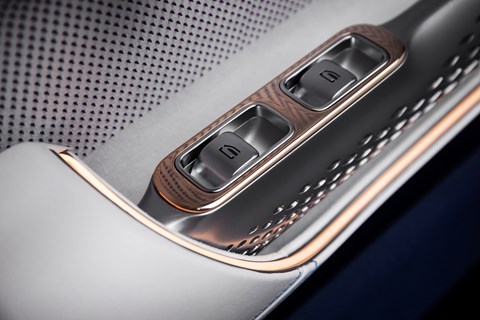
The body is a mix of steel made from scrap, plus carbonfibre, glassfibre and aluminium. The brake discs are lightweight aluminium, while the springs of the suspension units are glassfibre. The car’s design was aided by polygonal modelling tools from the 3D gaming industry and Hollywood animation, enabling the designers to identify with precision load paths that needed to be strong and other areas that did not need heavy reinforcement.
And look at that screen!
The electronic elements of the cabin are also simple – in a massive-screen kind of way. The EQXX trumps the EQS (which has three screens working together as one) by having one screen going the full width of the cabin, measuring 47.5 inches.
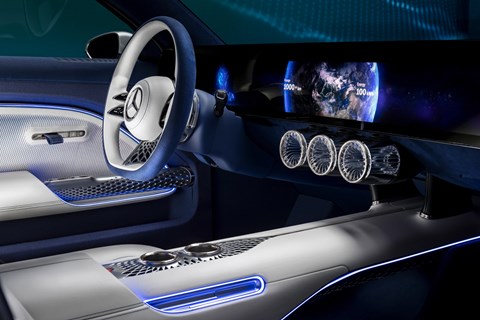
It’s designed to minimise energy consumption by only being active when required.
The interface is an evolution of that in the EQS, aiming to show you what you need when you need it. And there’s a new version of the ‘Hey Mercedes’ voice assistant with, we’re told, more personality than before. Even the audio system consumes less energy, by reducing the number of speakers and placing them close to the individual occupant, including two small speakers in each headrest.
Read our Mercedes reviews here